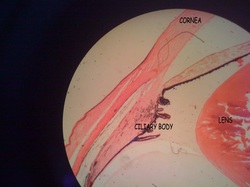
The ciliary body is an inward extension of the choroidea at the level of the lens. Ciliary processes are short extensions of the ciliary body towards the lens. A small amount of loose connective tissue similar to that of the choroid is located between smooth muscle cells which form the bulk of the ciliary body. They form three bundles, the ciliary muscle.
The inner surface of the ciliary body and its processes are lined by two layers of columnar cells which belong to the retina - the ciliary epithelium formed by the pars ciliaris of the retina. The outer cell layer is pigmented, whereas the inner cell layer, i.e. the layer that faces the posterior chamber of the eye, is nonpigmented.
The ciliary processes contain a dense network of capillaries. The cells of the inner layer of the ciliary epithelium generate the aqueous humor of the eye. , i.e. they transport the plasma filtrate generated by the capillaries in the ciliary processes into the posterior chamber of the eye. Thight junctions between the cells form the blood - aqueous humor barrier.
Fibers, which consist of fibrillin, extend from the ciliary processes towards the lens and form the suspensory ligament of the lens. These fibres are also called zonule fibres. Two of the bundles of the ciliary muscles attach to the sclera and strech the ciliary body when they contract, thereby regulating the tension of the zonule fibres. The reduced tension will result in a thickening of the lens which focusses the lens on close objects - a process called accomodation.
References : www.lab.anhb.uwa.edu.au
The inner surface of the ciliary body and its processes are lined by two layers of columnar cells which belong to the retina - the ciliary epithelium formed by the pars ciliaris of the retina. The outer cell layer is pigmented, whereas the inner cell layer, i.e. the layer that faces the posterior chamber of the eye, is nonpigmented.
The ciliary processes contain a dense network of capillaries. The cells of the inner layer of the ciliary epithelium generate the aqueous humor of the eye. , i.e. they transport the plasma filtrate generated by the capillaries in the ciliary processes into the posterior chamber of the eye. Thight junctions between the cells form the blood - aqueous humor barrier.
Fibers, which consist of fibrillin, extend from the ciliary processes towards the lens and form the suspensory ligament of the lens. These fibres are also called zonule fibres. Two of the bundles of the ciliary muscles attach to the sclera and strech the ciliary body when they contract, thereby regulating the tension of the zonule fibres. The reduced tension will result in a thickening of the lens which focusses the lens on close objects - a process called accomodation.
References : www.lab.anhb.uwa.edu.au